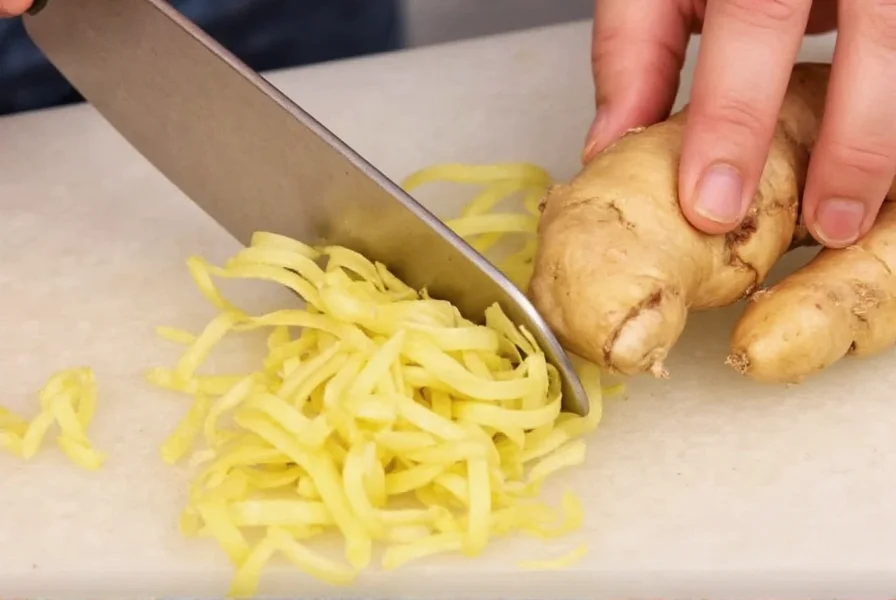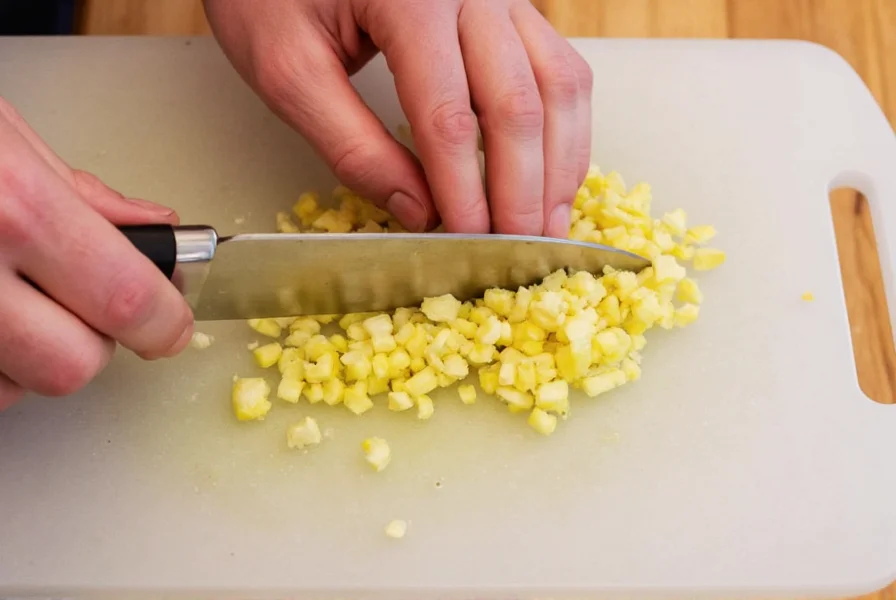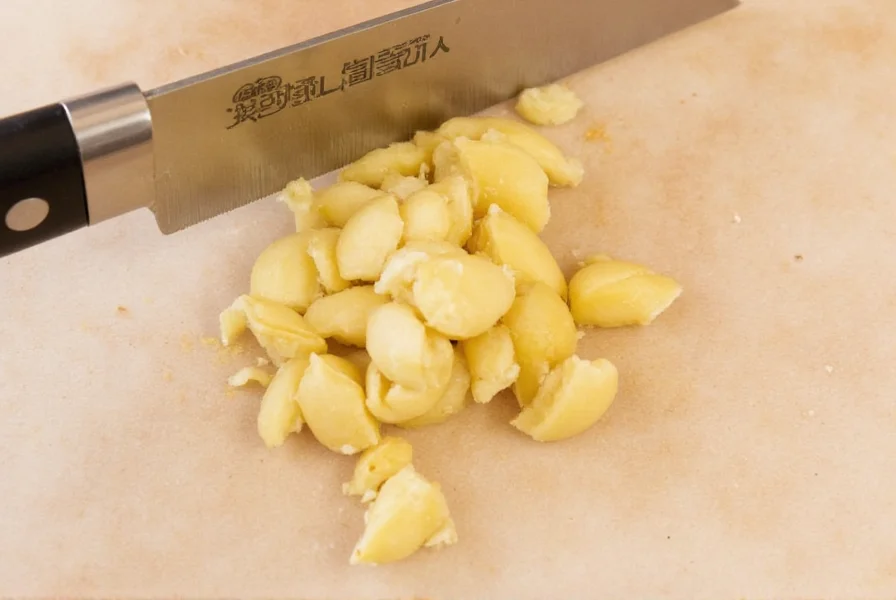Why Proper Ginger Mincing Matters in Cooking
Understanding how to mince ginger properly transforms your dishes. Unlike grated ginger which releases more liquid and has a sharper bite, finely minced ginger provides balanced flavor distribution without overwhelming other ingredients. When you mince ginger correctly, you maximize its aromatic compounds while maintaining the ideal texture for sauces, marinades, and stir-fries. Professional chefs prefer minced over grated ginger in most savory applications because it integrates seamlessly into dishes without creating fibrous strands.

Essential Tools for Mincing Ginger
While a sharp 8-inch chef's knife works best for traditional mincing, several alternatives exist depending on your needs:
| Tool | Best For | Texture Result |
|---|---|---|
| Chef's knife | Most cooking applications | Uniform, fine pieces with controlled size |
| Microplane grater | Baking or smooth sauces | Very fine, almost paste-like consistency |
| Food processor | Large quantities | Slightly uneven, can become pulpy if over-processed |
Step-by-Step Guide: How to Mince Ginger Perfectly
Follow these professional techniques to achieve restaurant-quality results every time you mince ginger:
Preparing the Ginger Root
Select firm, smooth ginger with tight skin—avoid roots with wrinkles or soft spots. The best ginger for mincing comes from the 'hand' section (the main bulbous part), not the thinner 'fingers' which contain more fibers. Before mincing ginger, wash the root thoroughly under cold water to remove any dirt.
Peeling Techniques That Preserve Maximum Flavor
Forget削皮刀—use the edge of a spoon to peel ginger. The spoon's curvature follows the ginger's natural shape, removing only the paper-thin skin while preserving the flavorful flesh beneath. This method wastes less ginger than traditional peelers and prevents removing too much of the valuable outer layer where many flavor compounds concentrate.
The Proper Knife Mincing Technique
Mastering how to mince ginger with a knife requires three precise steps:
- Slicing: Cut the peeled ginger into paper-thin slices (about 1/16 inch thick) against the grain. This breaks up the fibrous structure.
- Stacking: Gather 3-5 slices and stack them neatly.
- Mincing: Make fine parallel cuts through the stack, then rotate 90 degrees and repeat for a perfect dice. For finer mince, gather the pieces and rock your knife blade through them with a gentle motion.
This technique ensures you achieve consistently sized pieces that cook evenly. The key to proper ginger mincing is maintaining control of your knife—use a claw grip with your non-dominant hand to protect your fingers while guiding the blade.
Pro Tips for Better Ginger Results
Professional chefs know these insider techniques for how to finely mince ginger:
- Freeze first: Place peeled ginger in the freezer for 15-20 minutes before mincing. The slight firmness makes cutting cleaner and reduces stringiness.
- Use the 'squaring' method: Cut ginger into small squares before final mincing for more uniform results, especially helpful when learning how to mince ginger properly.
- Avoid the food processor trap: When mincing ginger in a food processor, pulse in short bursts and scrape down sides frequently. Over-processing creates a wet pulp rather than distinct minced pieces.
- Prevent sticking: Dip your knife blade in cold water between cuts when mincing large quantities to prevent ginger fibers from adhering to the blade.
Alternative Mincing Methods and When to Use Them
While the knife method produces the best texture, these alternatives work well in specific situations:
Microplane Method for Intense Flavor
When you need maximum flavor extraction in small quantities (like for dressings or desserts), use a microplane to create ultra-fine ginger particles. This method releases more volatile compounds but creates a wetter consistency than traditional mincing. Ideal for when you're mincing ginger for baking or delicate sauces.
Food Processor Approach for Large Batches
For mincing ginger in bulk (3+ tablespoons), a food processor works efficiently. Cut ginger into 1-inch pieces, add a teaspoon of neutral oil to prevent sticking, and pulse in 2-second intervals. Check frequently—ginger can go from minced to pulpy in seconds. This method works best for recipes where exact texture isn't critical, like soups or stews.

Troubleshooting Common Ginger Mincing Problems
Even experienced cooks encounter these issues when mincing ginger:
Dealing with Stringy Ginger
Ginger's fibrous nature sometimes creates stringy pieces. To prevent this, always cut across the grain (perpendicular to the fiber direction). If you notice stringiness, gather the minced pieces and make additional crosswise cuts with your knife. The freezer trick mentioned earlier also reduces stringiness by firming the fibers.
Storing Minced Ginger Properly
Don't waste your carefully minced ginger! Store it in an airtight container with a piece of paper towel to absorb moisture. Properly stored minced ginger keeps for 3-4 days in the refrigerator. For longer storage, freeze minced ginger in ice cube trays with a little water or oil—these ginger cubes work perfectly when you need to mince ginger for future recipes.
Frequently Asked Questions
What's the difference between minced and grated ginger?
Minced ginger consists of small, distinct pieces (about 1/16 inch) that distribute evenly in dishes, while grated ginger creates finer particles that release more liquid and have a sharper flavor profile. Mincing preserves more texture and provides gradual flavor release during cooking, whereas grating extracts maximum juice immediately. The best way to mince ginger produces pieces that maintain their integrity in sauces and stir-fries.
Can I mince ginger without a knife?
Yes, you can mince ginger without a knife using alternative methods. A microplane grater creates very fine ginger pieces suitable for many applications, while a food processor works for larger quantities. For emergency situations, freeze peeled ginger and use the fine holes of a box grater, then gather and chop the resulting shreds with a spatula. However, the traditional knife method remains the best way to mince ginger for precise texture control.
How fine should minced ginger be?
Properly minced ginger should measure about 1/16 inch (1.5mm) in size—small enough to distribute evenly through dishes but large enough to maintain texture. When learning how to finely mince ginger, aim for pieces no larger than a grain of rice. The ideal mince should resemble coarse sand rather than a paste. This size ensures optimal flavor release without disappearing into sauces or creating unpleasant fibrous strands in your finished dish.
Why does my minced ginger become stringy?
Ginger becomes stringy when you cut with the grain rather than across it. To prevent stringiness when mincing ginger, always slice perpendicular to the fiber direction (which runs lengthwise through the root). Freezing the ginger for 15-20 minutes before mincing also firms the fibers and reduces stringiness. If your minced ginger is already stringy, gather the pieces and make additional crosswise cuts with your knife to break up the fibers.











 浙公网安备
33010002000092号
浙公网安备
33010002000092号 浙B2-20120091-4
浙B2-20120091-4